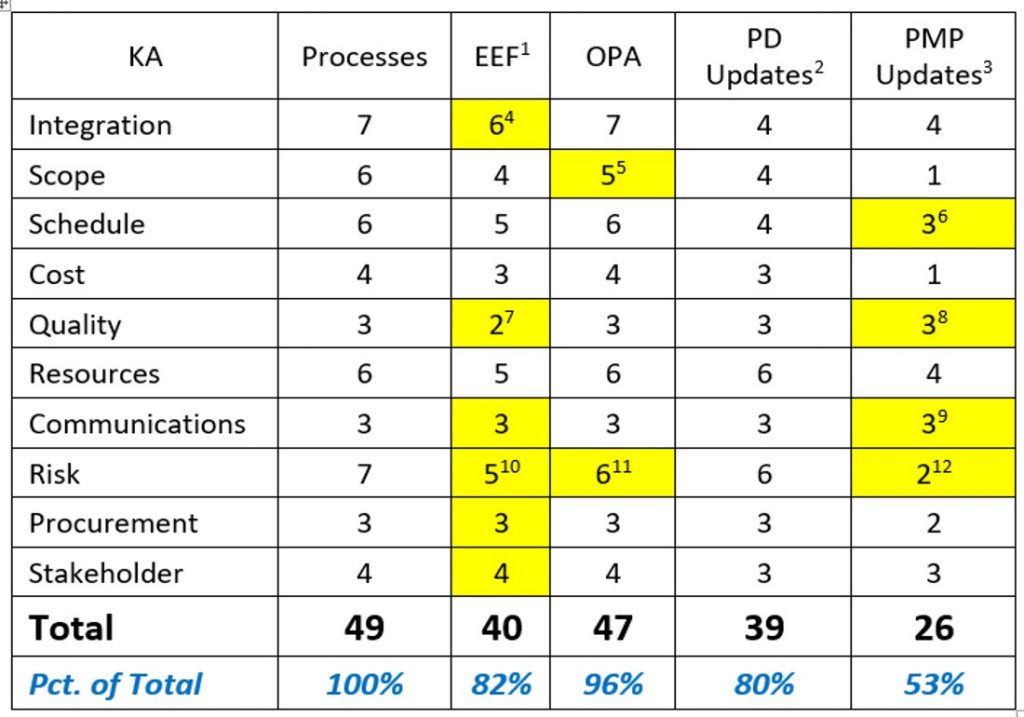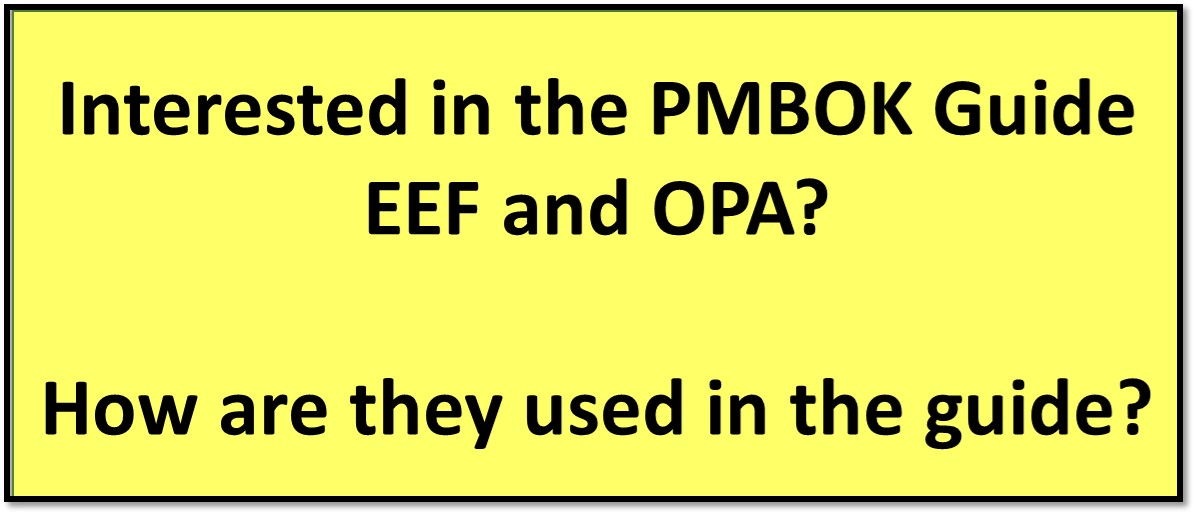As we continue to review the PMBOK Guide we decided to check a few items, stats of interest to us. Things like how many processes has EEF or OPA as input and why.
Read on
The Numbers, Part 1
Let us start with the easy part.
- Total number of process is 49
- We still have 5 process groups and 10 knowledge areas
Now let us move to a more complex topic. For this, refer to the table first. There are some interesting facts and figures here and some of it does not make sense to us. In this post, we will explore some and we are likely to revisit this topic in the future.
Discussions, after the table.

EEF: Enterprise Environmental Factors
- Number and percent of processes with EEF as input are 40, and 82%, respectively.
- Typically, the monitoring and controlling processes do not have EEF, with exception to Integration and others; refer to footnotes for the exceptions.
- Further, three of the knowledge areas, Communications, Procurement, and Stakeholders have EEF as input to all of their processes.
We are trying to understand the above but so far no answer. Does anyone have an idea?
Let us look at the definition of EEF in the Standard (Part 2): “These factors refer
to conditions, which are not under the control of the project team …” and “These factors refer
to conditions, which are not under the control of the project team …”
If we refer to this definition, then why would not some of the processes have EEF influences?
OPA: Organizational Process Assets
This one might seem easier but still, raises a question.
- The number and percent of processes with OPA as input are 47 and 96%, respectively. This means almost all of them.
- Only Validate Scope and Monitor Risks do not have OPA as input. Not sure why.
- We would think that every process must have a link to the OPA. Does anyone has answers??
Project Document Updates
Number and percent of processes with project documents updates as output are 39 and 80%, respectively.
There are no significant items to raise here since it is logical that many project documents will be updated as an output of some of the processes. Now, is 39 the right number? Should it be more or less? We did not investigate this point.
Project Management Plan Updates
This topic does raise a few questions.
The number and percent of processes with project management plan updates as output are 26 and 53%, respectively. OK, nothing to report here.
Usually, only executing and controlling processes have PMP Updates. This makes sense since while we are in planning, we are still working on the plan — in other words, we have “work in progress” so we do not usually use the term updates at this time.
However, there are a few exceptions that we do not understand. Refer to table and footnotes. Some examples:
- In schedule management there are some planning processes with PMP Updates, we could not understand why.
- The same thing in quality and communications, their Plan X Managment processes have PMP updates.
- In risk management, only one of the planning processes has PMP update.
Can anyone explain the above to us so we can learn? Again, our logic and expectations is that while the PMP is being developed, it is work in progress and no updates until after approval of the PMP.
We can speculate that maybe as we review the PMP in later phases these updates happen. If that is the case, then would not most of the PMP processes will have updates?
It is possible that I have not read enough, hence the confusion.
Closing Remarks
We will have another post on PMBOK Guide numbers but tackling another subject, the process categories.
We would love to hear your thoughts.
Footnotes
[1] Typically, the monitoring and controlling processes do not have EEF, with exception to Integration, quality, communications, procurement, and stakeholders.
[2] Project Documents Updates
[3] Usually Executing and Controlling Processes have this
[4] Only closing process does not have the EEF. The two controlling processes have it.
[5] Only validate scope does not have it
[6] Usually only E & C Processes but here we have two planning processes with the PMP Updates; is this logical?
[7] In this case the control process has EEF but the executing process does not
[8] Interesting to see that all processes have the PMP Updates … again for planning does not make sense
[9] All has it
[10] E & C do not have it
[11] Monitor Risks do not have it
[12] Include a planning process

